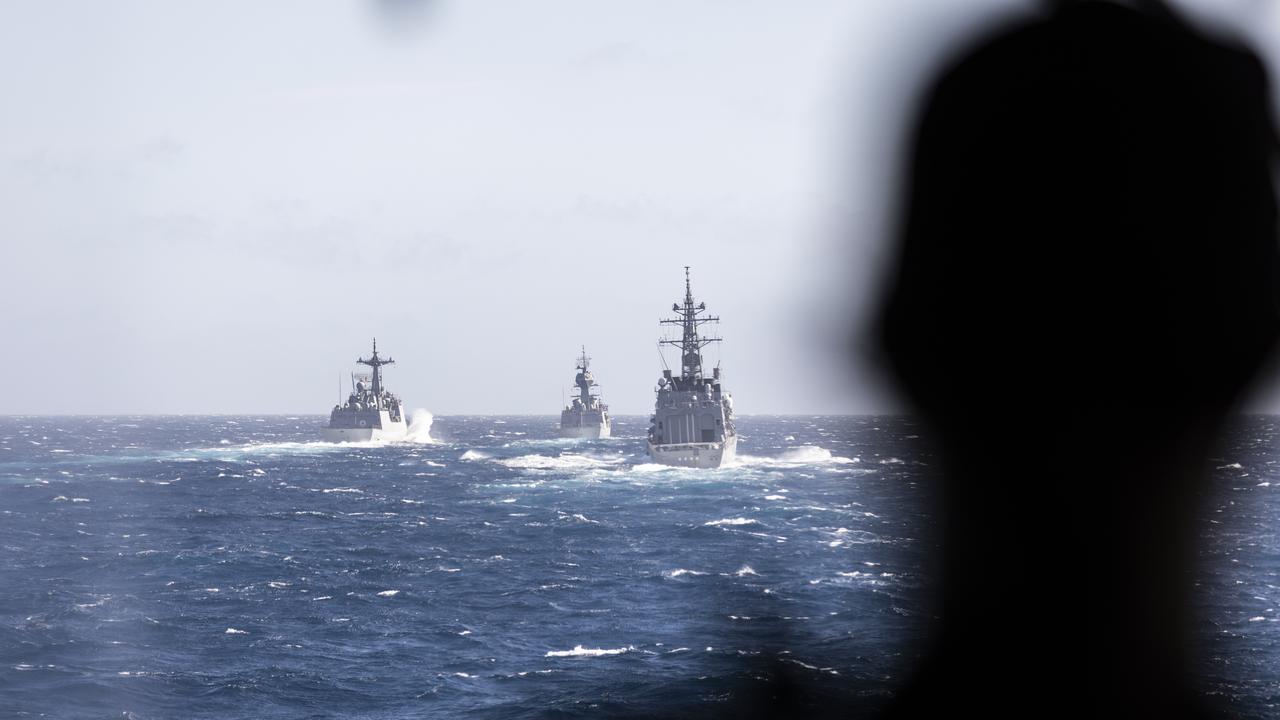Chinese spy ships off Australia is the ‘new normal’
China has sent two spy ships off Queensland’s coast. And there is a clear reason why Beijing will do more of the same in the future.
Defence Minister Peter Dutton says he is “surprised” China has sent two surveillance ships to monitor war-games on Queensland’s coast.
But the scenario being played out is the sum of Beijing’s fears – a broad coalition fighting to establish a beachhead in occupied territory.
The massive, fortnight-long Biennial Talisman Sabre military exercise kicked off last week. Six nations are taking part. Another six have sent observers.
One of them isn’t as welcome as the others.
Beijing has – for the first time – sent two large, modern surveillance ships to watch its every move.
Former Royal Australian Navy rear admiral and ANU adjunct professor James Goldrick told News Corp that Australia must recognise this as the “new normal”.
China is here because they believe they need to be, he says.
And also because they now can.
“China obviously has strategic concerns,” he says. “And all the most sophisticated periphery powers to its First Island Chain are taking part.”
Talisman Sabre will test every element of allied military co-operation, co-ordination and operations.
“They’re very interested because of the strategic scenario being tested,” he says.
“They’re interested because this is the most substantial exercise of this type. And they’re interested because they can be interested. I would think they’d want to listen to and watch as much as they can.”
RELATED: China threatens to nuke Japan if it intervenes in Taiwan

Strategic relevance
“This sends a message to our friends and to our foes that we have the deepest of relationships with the United States,” Defence Minister Peter Dutton said while watching the action at the Shoalwater Bay training area yesterday.
“Our partnership with America, with Japan, with the United Kingdom, with New Zealand and with others in the Indo-Pacific region should send a strong message to the Communist Party and others that we have a great capacity, we have a great deterrence, and we will do whatever it takes to keep peace in our region.”
The US is the most prominent participant outside Australia. Canada and New Zealand are taking part. Japan is contributing a specialist contingent. And, for the first time, South Korea has sent a warship.
The war game game scenario itself is of particular interest to Beijing. And Japan.
.@USMC and #USNavy aircraft conduct flight operations aboard @US7thFleet amphibious assault ship #USSAmerica on Saturday as exercise @TalismanSabre takes off in the Coral Sea. #LHA6#BlueGreenTeam#TS21pic.twitter.com/c1fi5f4SEn
— U.S. Pacific Fleet (@USPacificFleet) July 19, 2021
It’s an amphibious assault. It’s about using warships to escort and deliver a force of tanks and troops into hostile territory and seize control of a beachhead.
But Japan’s Self Defence Force has sent a specialist island warfare unit. It’s there to practice defending territory China also claims.
“Amphibious manoeuvres are critical to defending the Nansei Islands, which is one of Japan’s top defence priorities,” Chief of Staff General Yoshihide Yoshida said. “Bolstering our tactical skills will strengthen our defence capabilities.”
What it takes for diverse allies such as Japan, South Korea and Australia to work together is what the Chinese spy ships will be examining. All while gathering every scrap of signals data they can.
Growing capability
“You have sophisticated, substantial naval forces,” Goldrick says.
“You have sophisticated, substantial air assets. And you’ve got sophisticated and substantial land activity. Then go and look at the size of the exercise area. If you genuinely want to conduct a practical intelligence-gathering operation on all that, even two of these big Chinese ships will be flat out trying to take it all in.”
This isn’t new. Surveillance ships are a perfectly normal part of international relations.
It’s just that they haven’t been a feature of regional relations for some time.
“We are surprised there are two vessels, but obviously, the Chinese have made a decision to have a greater presence,” Mr Dutton told reporters. “We would expect them to operate and conduct themselves within the rules of international law.”
But Goldrick says we should expect much more of the same.
“It’s a new normal that’s in parallel with the old normal of the Cold War,” he says.
In his time on exchange service with the British Royal Navy, Goldrick says Soviet vessels would monitor most significant missions and exercises. Some also showed intense interest in the east coast of Australia in the 1960s as the ADF tested its then-new Ikara guided anti-submarine missile-torpedo system.
That China is now doing so is both a symptom of Beijing’s “diplomatic freeze” and its growing naval might.
And with new capability comes the need to play safe.
Goldrick says his experience with Soviet spy ships in the 1980s was good-natured and professional “because everybody knew what the rules were”.
It’s not so much about the conventions and rules of the sea, he says, as it is about individual nations’ operational instructions.
“These are the things that really matter, that actually tell commanding officers what to do in particular circumstances, so you don’t get too close,” he says.
“Frankly, it’s all about reasonable behaviour. It’s about minimising risk”.
RELATED: China builds new Great Wall as global sea conflict escalates

Sum of all fears
Goldrick says one complication is Beijing’s “siege mentality” – an attitude shaped by the way China’s coastline is walled off by chains of islands. These produce narrow choke points that can deny access – either in or out – of the East and South China Seas.
China also has a lot to learn about becoming a maritime superpower, he adds.
“For the first time in their history, they’re not just a maritime power,” he says. “They’re a maritime-dependent power.”
China’s oil and gas is supplied by sea. Its economy is driven by seaborne trade.
“And don’t forget it’s all tied up with their ‘Century of Shame’,” Goldrick adds. “The big difference between then and China’s earlier past is that the ‘barbarians’ didn’t invade over The Steppes. They came by sea”.
This is why the United States and its allies practising amphibious assault plays on its fears.
“At least as much as Beijing wants it to,” he says. “As far as the Chinese themselves are concerned, it will be what the Chinese government tells you. Beijing can make as much or as little of an event like this as it wants.”
For the moment, Beijing has chosen to downplay its significance.
Sailing for #TS21 🚢ðŸ‘#HMASCanberra and her embarked crew are heading to #TalismanSabre to conduct amphibious operations with our #AlliesAndPartners. 💪#AusNavy@Australian_Navypic.twitter.com/82th800vnt
— Talisman Sabre (@TalismanSabre) July 17, 2021
Instead, it’s focused on the Australian reaction to the presence of its ships.
“It is unreasonable to exaggerate the legal presence of the Chinese ships as threats when Western countries like the US are frequently conducting close-in reconnaissance activities on China from both sea and air, which are much riskier,” the state-controlled Global Times quoted an unnamed military expert as saying this weekend.
But that is in itself an admission of the old-new normal, Goldrick says.
“This is recognition of the fact that China clearly understands that military intelligence operations are acceptable in other people’s Exclusive Economic Zones,” he says.
“And it’s time they acknowledge this in relation to their own. Otherwise, it’s hypocrisy. And that’s a demonstration of some of the diplomatic problems we’re having.”
Beijing’s attitude has been characteristically belligerent.
“Western countries should get used to China’s legal maritime activities as the PLA Navy continues to develop,” the Global Times states.
Goldrick agrees.
“More and more of these intelligence ships are becoming available to Beijing,” he says. “They’ve now got capabilities they didn’t have just a few years ago.”
Jamie Seidel is a freelance writer | @JamieSeidel




